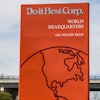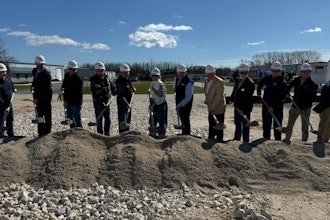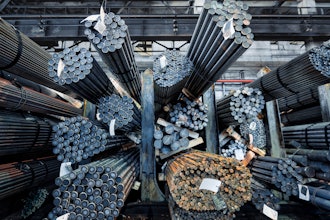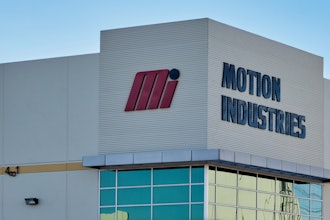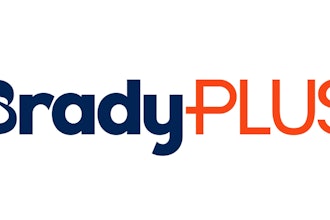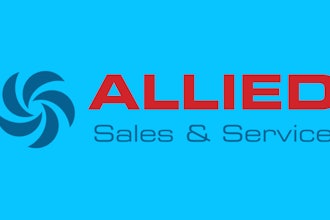Canton, OH - The Timken Company reported sales of $4.3 billion for 2013, a decrease of 13 percent from the prior year. The decline reflects lower demand across most of the company's broad end markets. In addition, a $117 million decline in Steel segment raw material surcharges from the prior-year period further decreased revenues. The reduction in sales was partially offset by the benefit of acquisitions of $86 million in the company's Mobile Industries and Process Industries segments and from strength in the Steel segment's automotive end-market sector.
In 2013, the company generated net income of $262.7 million, or $2.74 per diluted share, compared with $495.5 million, or $5.07 per diluted share, a year ago. Results for 2013 included $32.8 million of after-tax expense, or $0.35 per diluted share (reference Table 1) related to (a) tax expense incurred on the repatriation of overseas cash, (b) tax benefits associated with the reversal of certain income tax reserves from prior years, (c) separation costs associated with the proposed spinoff of the steel business, (d) costs related to previously announced plant closures, and (e) other unusual items. Excluding these items, 2013 net income was $295.5 million, or $3.09 per diluted share. This compares with 2012 net income of $464.6 million, or $4.76 per diluted share, excluding costs related to previously announced plant closures and Continued Dumping and Subsidy Offset Act (CDSOA) receipts. The decrease in earnings primarily reflects lower volume and manufacturing utilization as well as unfavorable sales mix, which was partially offset by lower raw material and selling and administrative expenses as well as favorable pricing.
Table 1: Net Income and Diluted Earnings Per Share (EPS) | ||||
2013 | 2012 | |||
($ in Mils.) | EPS | ($ in Mils.) | EPS | |
Net Income attributable to The Timken Company | $ 262.7 | $ 2.74 | $ 495.5 | $ 5.07 |
Adjustments: | ||||
Tax expense on cash repatriation | 26.2 | 0.28 | ||
Reversal of income tax reserves | (12.3) | (0.13) | ||
Steel separation-related costs | 10.3 | 0.11 | ||
Severance due to cost-reduction initiatives | 3.9 | 0.04 | ||
Gain on sale of real estate in Brazil | (5.4) | (0.06) | ||
Charges due to plant closures | 8.3 | 0.09 | 37.1 | 0.38 |
CDSOA expense (receipts) | 1.8 | 0.02 | (68.0) | (0.69) |
Net Income, after adjustments | $ 295.5 | $ 3.09 | $ 464.6 | $ 4.76 |
"Although demand from many of our targeted market segments has been sluggish, we performed well despite low operating levels," said James W. Griffith, Timken president and chief executive officer. "Over the past few months, we have completed a number of initiatives to match our cost structure to the current demand and to improve our ability to grow. The company is well positioned as key markets begin to recover in both businesses even as we prepare for an anticipated mid-year separation of our steel business."
During 2013, Timken:
Invested for Growth and Productivity
- Acquired Smith Services, Interlube Systems, Standard Machine and rail bearing reconditioning assets from The Greenbrier Companies;
- Completed four previously announced capital investment projects that will increase manufacturing effectiveness and capacity in its Steel segment;
- Announced the opening of its new industrial service center in Raipur, India, which will provide gear drive and bearing repair and upgrade services to meet growing customer demand for Timken industrial services outside the U.S.; and
- Expanded its product portfolio, launching new Timken® SNT plummer blocks and seals, adding new Timken® encoders and designing two new high-performance Timken® alloy steels to meet specific needs of the oil and gas industry.
Returned Capital to Shareholders
- Through dividends and the repurchase of 3.4 million shares, returned a total of $277 million in capital to shareholders. The company has 4.1 million shares remaining under its current board-approved share repurchase program.
Implemented Cash Repatriation Strategy
- In the fourth quarter, implemented a strategy to repatriate approximately $365 million of cash, incurring tax expense of approximately $26 million. The company repatriated $123 million of cash in January 2014; the rest will be repatriated in future periods.
Launched Cost-Reduction Initiative / Continued Rationalization
- Began a cost-reduction initiative in the fourth quarter to address lower market demand within its bearings and power transmission business. The company expects pre-tax costs of approximately $20 million to achieve targeted annual pre-tax savings of approximately $25 million; and
- Continued to further align its operations during the year with market needs, which includes supply chain improvements, work force reductions and plant capacity rationalizations.
Began Steel Separation Initiative
- On September 5, 2013, announced intent to pursue a separation of the company's steel business through a tax-free spinoff, creating a new independent publicly traded steel company mid-year 2014. At that time, the new company—TimkenSteel Corporation—is expected to trade on the New York Stock Exchange under the ticker TMST; and
- In anticipation of the spinoff, the company expects to incur one-time separation costs of approximately $105 million. Included in these costs are $15 million related to another specific cost-reduction initiative to generate an additional $20 million of annualized savings, which are intended to mitigate the incremental enterprise costs associated with operating TimkenSteel Corporation as an independent public company.
Fourth-Quarter Results
Timken posted sales of $1.1 billion in the fourth quarter of 2013, down 2 percent from the same period in 2012. The sales decrease primarily reflects lower demand from the industrial, mining, heavy-truck and light-vehicle end-market sectors. This decrease was partially offset by demand in the energy, rail, Aerospace-related defense and Steel-related light-vehicle end-market sectors as well as the benefit of acquisitions. From a geographic perspective, the decline primarily reflects lower demand in North America, partially offset by growth in Asia.
For the fourth quarter, the company generated net income of $52.6 million, or $0.55 per diluted share. That compares with $75.3 million, or $0.78 per diluted share, earned in the same period last year. Results for 2013 included $20.9 million of after-tax expense, or $0.23 per diluted share (reference Table 2) related to (a) tax expense incurred on the repatriation of overseas cash, (b) tax benefits associated with the reversal of certain income tax reserves from prior years, (c) separation costs associated with the proposed spinoff of the steel business, (d) costs related to previously announced plant closures, and (e) other unusual items. Excluding these items, fourth-quarter net income was $73.5 million or $0.78 per diluted share. This compares with 2012 fourth quarter net income of $77.9 million, or $0.80 per diluted share, excluding costs related to the previously announced plant closures. The decline in earnings primarily reflects lower volume and the impact of LIFO, partially offset by lower selling and administrative expenses and material costs.
Table 2: Net Income and Diluted Earnings Per Share (EPS) | ||||
4th Quarter 2013 | 4th Quarter 2012 | |||
($ in Mils.) | EPS | ($ in Mils.) | EPS | |
Net Income attributable to The Timken Company | $ 52.6 | $ 0.55 | $ 75.3 | $ 0.78 |
Adjustments: | ||||
Tax expense on cash repatriation | 26.2 | 0.28 | ||
Reversal of income tax reserves | (12.3) | (0.13) | ||
Steel separation-related costs | 10.3 | 0.11 | ||
Severance due to cost-reduction initiatives | 3.9 | 0.04 | ||
Gain on sale of real estate in Brazil | (5.4) | (0.06) | ||
Charges due to plant closures | (3.3) | (0.03) | 2.2 | 0.02 |
CDSOA expenses | 1.5 | 0.02 | 0.4 | - - |
Net Income, after adjustments | $ 73.5 | $ 0.78 | $ 77.9 | $ 0.80 |
Cash Flow and Balance Sheet
The company generated $432.4 million in cash from operating activities in 2013, driven by earnings and working capital management, partially offset by discretionary pension contributions. Excluding discretionary pension contributions of $66.3 million, net of tax, and CDSOA expense of $1.8 million, net of tax, free cash flow (operating cash after capital expenditures and dividends) was $87.2 million. In addition, the company repurchased 3.4 million shares for $189 million and made three acquisitions totaling $65 million.
As of December 31, 2013, total debt was $475.9 million, or 15.2 percent of capital, and cash was $384.6 million, resulting in net debt of $91.3 million, compared with total debt of $479.0 million and a net cash position of $107.4 million at the end of 2012. Available liquidity at December 31, 2013, was $1.2 billion. Timken ended the year with pensions funded at approximately 105 percent compared with 89 percent a year ago.
Mobile Industries Segment Results
Mobile Industries' 2013 sales were $1.5 billion, down 12 percent from $1.7 billion a year ago. The decrease included approximately $95 million related to the company's market strategy, primarily in the light-vehicle sector. The remaining decrease was principally due to lower heavy truck and off-highway market demand, partially offset by the benefits of the Interlube Systems acquisition and rail bearing reconditioning investment, combined with higher demand from the automotive aftermarket sector.
Mobile Industries achieved EBIT of $164.7 million, or 11.2 percent of sales, for the year, down 21 percent from $208.1 million, or 12.4 percent of sales, earned in 2012. The decrease in EBIT was primarily driven by lower volume and plant utilization, partially offset by lower costs related to plant closures, raw materials and selling and administrative expenses.
In the fourth quarter, Mobile Industries' sales were $337.1 million, down 7 percent relative to the same period a year ago. The $24 million decrease included approximately $30 million related to the company's market strategy primarily in the light-vehicle sector. The remaining growth was mainly due to improved international rail demand and the benefit of acquisitions. EBIT for the quarter was $32 million, or 9.5 percent of sales, compared with $34.7 million, or 9.6 percent of sales, for the same period a year ago. EBIT was impacted by lower volume and plant utilization, partially offset by lower selling and administrative expenses and the benefit of acquisitions. In addition, the company had a net benefit of approximately $8 million from unusual items, including the gain on the sale of land in Brazil and lower restructuring costs compared to a year ago, partially offset by severance costs related to the company's cost-reduction initiative.
Process Industries Segment Results
Sales for the Process Industries segment were $1.2 billion in 2013, a decrease of 8 percent from $1.3 billion a year ago. The decrease was driven by lower demand and inventory destocking in the industrial distribution market sectors, led by mining, oil and gas, as well as lower demand in the original equipment industrial sectors including metals, gear drives and wind. The decrease was partially offset by the benefit of the industrial services acquisitions as well as pricing.
Process Industries generated EBIT of $201.9 million, or 16.3 percent of sales, down 27 percent from the prior year's EBIT of $274.9 million, or 20.5 percent of sales. The decrease reflects lower volume and plant utilization partially offset by pricing and lower selling and administrative expenses.
Process Industries' fourth-quarter sales were $324.7 million, down 4 percent from the same period a year ago. The decrease reflects lower industrial distribution market sector demand, primarily in the U.S., as well as lower industrial original equipment demand across most end-market sectors. The decrease was partially offset by the benefit of the industrial services acquisitions. EBIT for the quarter was $53.9 million, or 16.6 percent of sales, compared with the prior year's fourth quarter EBIT of $61.2 million, or 18.1 percent of sales. The decrease in EBIT resulted from lower volume, partially offset by lower manufacturing and material costs and selling and administrative expenses. In addition, Process Industries had approximately $3 million of expense from unusual items, primarily consisting of severance costs related to the company's cost-reduction initiative.
Aerospace Segment Results
For the full year 2013, Aerospace recorded sales of $329.5 million, down 5 percent from $346.9 million in 2012. The decrease reflects lower shipments to the defense and critical motion market sectors.
Aerospace EBIT was $26.6 million, or 8.1 percent of sales, down 27 percent from $36.3 million, or 10.5 percent of sales, for the same period a year ago. The decrease in EBIT was driven primarily by lower volume and higher manufacturing costs, partially offset by pricing and lower selling and administrative expenses.
Sales for the fourth quarter were $88.7 million, up 5 percent from the same period a year ago. The increase reflects higher volume, led by the defense sector. EBIT for the fourth quarter was $5.2 million, or 5.9 percent of sales, compared with EBIT of $10.0 million, or 11.8 percent of sales, in the same period a year ago. The decrease in EBIT resulted from higher manufacturing costs as the segment reduced inventory levels, and restructuring charges of $2 million, which were partially offset by improved market demand.
Steel Segment Results
Sales for Steel, including inter-segment sales, were $1.4 billion in 2013, down 20 percent from $1.7 billion last year. The results reflect reduced shipments to the industrial and oil and gas market sectors, partially offset by improved demand in the mobile on-highway end-market sector. Raw-material surcharges decreased approximately $117 million from 2012. Steel segment EBIT for the year was $140.2 million, or 10.2 percent of sales, down 44 percent compared to $251.8 million, or 14.6 percent of sales, in the prior year. EBIT was impacted by lower volume, mix, surcharges and LIFO income, partially offset by lower material, manufacturing and selling and administrative expenses.
For the quarter, Steel segment sales were $330.1 million, up 4 percent from the same period last year driven by demand in the mobile on-highway and oil and gas end-market sectors. Raw-material surcharges increased approximately $7 million from the fourth quarter in 2012.
EBIT for the fourth quarter of 2013 was $32.9 million, or 10 percent of sales, compared with $25.2 million, or 8 percent of sales, for the same period a year ago. The increase in EBIT was driven by higher volume and lower manufacturing costs, net material costs and selling and administrative expenses, partially offset by the impact of LIFO.
Outlook
The company's outlook reflects its current business structure with all four operating segments in place for the full 12 months of 2014. Timken expects 2014 sales to be up approximately 6 percent compared to 2013, driven by higher demand in industrial, off-highway, energy, defense and rail end-market sectors. Operating performance is expected to benefit from higher demand and cost-reduction initiatives, with all four segments achieving double-digit operating margins.
For the full year 2014, The Timken Company expects:
- Mobile Industries' sales down 3 to 8 percent, primarily driven by the impact of planned program exits in the light-vehicle sector that concluded by the end of 2013. Partially offsetting this decline is anticipated improvement in off-highway and rail demand;
- Process Industries' sales to be up 7 to 12 percent, due to recovery across most industrial end-market sectors;
- Aerospace and Defense sales up 5 to 10 percent, due to increased demand across most end-market sectors, led by defense; and
- Steel sales up 12 to 17 percent, driven by improved demand in the oil and gas and industrial end-market sectors.
Timken projects 2014 annual earnings per diluted share to range from $3.15 to $3.45, which includes $0.35 per diluted share of the following unusual items: separation costs related to the proposed spinoff of the steel business of $0.55; costs associated with the company's cost-reduction initiative of $0.10; and a gain on the sale of land in Brazil of $0.30.
The company expects to generate cash from operations of approximately $560 million in 2014. Free cash flow is projected to be $165 million after making capital expenditures of $310 million and paying about $85 million in dividends.



